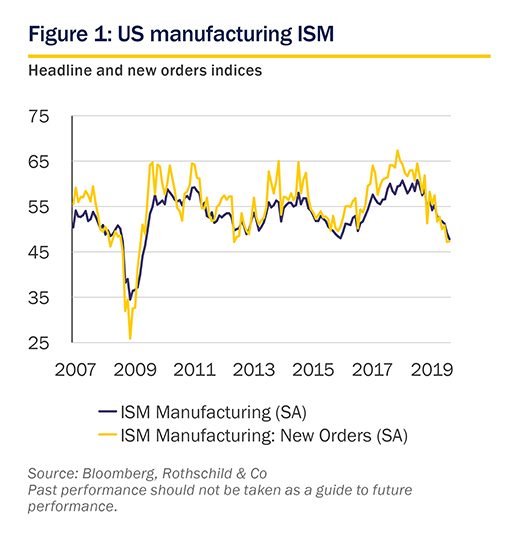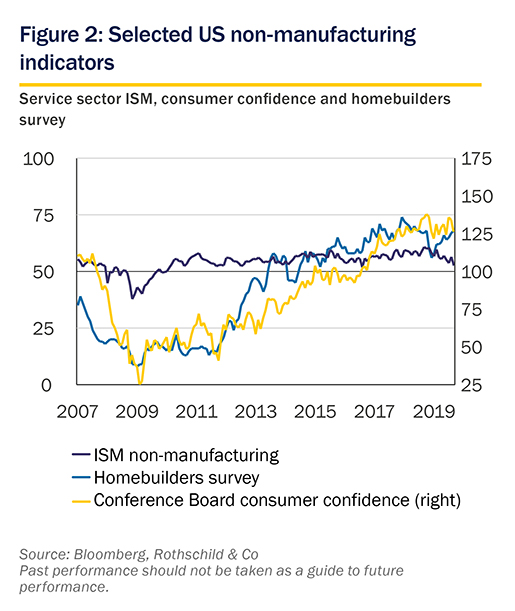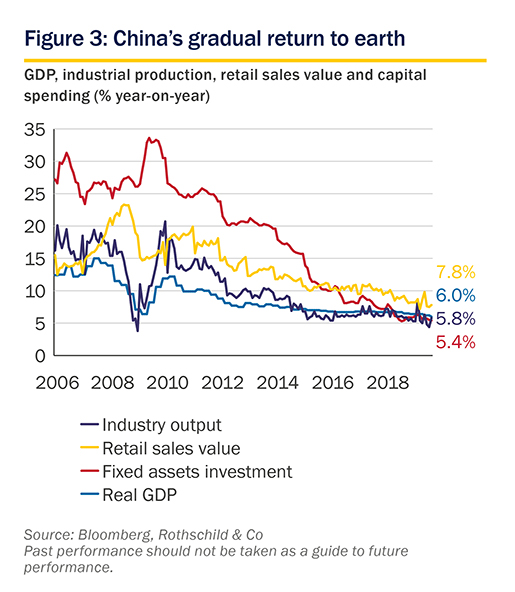Market Perspective – Slowing, not collapsing

Kevin Gardiner, Global Investment Strategist, Wealth Management
Could stability break out soon?
The global economy has been slowing now for almost two years, since early 2018. Investors' - and central bankers' - nerves never really recovered from the trauma of the Global Financial Crisis (GFC), and the slowdown has understandably fuelled concerns that history is about to rhyme again.
Indeed, one of our 'desert island stats', the manufacturing ISM survey for the US, fell sharply in the last two months. It has not yet hit levels that would usually be thought to signal US recession, but it is closer to them than at any time since the GFC, having moved beneath the previous post-GFC trough (figure 1 - October reading imminent).

Click the image to enlarge
Unfortunately, the macro picture is blurred by some one-off micro developments. A dramatic downturn in the auto and aviation sectors may be having a bigger impact on global manufacturing than we'd realised.
From China to Europe and the US, auto emissions controls and sensibilities, and a switch to electric power and (more tentatively) automated driving capabilities, have hit production - and demand. How many of us are not buying new motors because we're waiting to see what comes next? The strike at GM in the US (now ended) added to the sector's woes - and it is also centre-stage in US-EU trade negotiations. Boeing's problems with its 737 may also be having a bigger impact than we'd realised, and airframes too are in play in US-EU trade talks.
This is all still bad news for business, and part of the cyclical slowdown. But it may not be telling us much about (for example) the underlying state of consumer confidence, the availability of finance or businesses' capital spending plans. Whether such weakness warrants a monetary policy response must be debatable. And the stage may be set for a vigorous catch-up as a potentially more consolidated auto sector gets its act back together.
Brexit uncertainties seem also to have been playing a role, though we suspect that the UK inventory cycle(s) that they have fostered have been more potent than the more widely discussed shortfall in business capex, which is volatile at the best of times. And guess who has some of the most vertically integrated supply chains in European manufacturing? Autos and airframe production.
As we write, the risk of a disruptive no-deal UK exit from the EU seems to have faded. We have said that before, only for it to revive. Meanwhile, a potentially game-changing UK election is at hand (see below). But we continue to suspect that leaving the EU - even without a deal - will not be as economically traumatic for the UK as many fear, and that a clear win for the main opposition party is possible but not yet probable.
Service sector indicators in the US (figure 2) and globally have also weakened in recent months, but they generally remain further above potentially recession-indicating levels. And in the US, some cyclical indicators have been rising - housing starts and building permits, for example, helped no doubt by lowered interest rates (though market expectations of further falls are being reined-in, as we'd guessed they might be). Another of our 'desert island stats', US retail spending, looks resilient, as does consumer confidence (figure 2) - and corporate results: third-quarter earnings data released so far suggest earnings growth may have bottomed a little sooner than we'd thought.

Click the image to enlarge
Finally, while China's economy has once again got its share of negative headlines - the slowest growth since 1992 - the slowdown under way remains gradual (figure 3). China cannot sustain even 6% growth in the long term, but it will be some time before its trend growth rate falls to western levels.

Click the image to enlarge
The markets and business surveys are clearly still vulnerable to a re-escalation (should that be a re-re-escalation?) of trade tensions. Stock markets are close to their highs. But there may be a little more tactical headroom than there was. Presidential tweets aside, we suspect the manufacturing indicators may be close to bottoming out, and with US consumer cashflow still healthy, and confidence underpinned by a still-tight labour market, we continue to see this episode as a rather late 'mid-cycle' pause rather than something more sinister. To a large extent, it is a mirror image of the surge in growth that caught economists by surprise in 2017. The muddle-through cycle may yet make it into 2020.
Click here to continue: Market Perspective: Protest or pendulum?
In this Market Perspective:
- Foreword
- Slowing, not collapsing (current page)
- Protest or pendulum?
- Economy and markets: background
- Important information
Download the full Market Perspective in PDF format (PDF 716 KB)